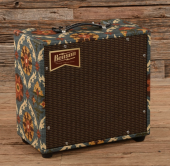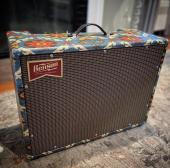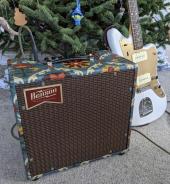Electronic Audio Experiments The Bard
Brands:
The Bard is an homage to one of our favorite misunderstood amplifiers of the past: the Music Man HD130. Manufactured from 1974 to 1984, these amps combined a solid state preamp with a tube power amp, an unusual choice that lead to them being gravely underrated in their time. But the HD130 and its siblings are some of our favorite amps thanks to their pristine (but not quite vintage) clean tones, trashy overdrive, and very wide frequency response that suits both guitar and bass. Because we love a weird passion project, we editorialized our favorite parts of this cult classic into a compact overdrive pedal: The Bard.
The Bard’s circuitry resembles a classic 1960s American amplifier reimagined with op amps in the place of tubes. The clean tones are clear and sparkly, with a gentle dip in the midrange thanks to the passive tone stack. Increasing Drive delivers medium gain sounds with a glassy edge, especially when the Bright switch is active. At the highest Drive settings, the op amps distort in a way that is unapologetically not “tube-like”—a hallmark of the original amps. The tone stack is located before the primary gain stage and can emphasize specific textures within the overdriven sound. The Bard is a versatile performer that will effortlessly traverse between traditional and angular stylings.
Controls
-
Level: turn clockwise to increase the output volume. Handy as a boost!
-
Drive: Increases the gain, from clean to touch sensitive to heavily overdriven. The taper of the control is highly influenced by the EQ settings and the position of the Bright/Normal switch.
-
Low: passive bass control, with about 15dB of range below 300Hz. Higher settings will make the drive more fuzzy.
-
High: passive treble control, approximately 15dB of range between 1kHz-4kHz. Higher settings will increase gain for high frequencies, sharpening the drive sound.
-
Bright/Normal Switch: Changes the treble contouring of the Drive control. At low drive settings, adds a glassy character. As drive is increased, the switch is more subtle. At maximum drive, the switch makes no discernible difference in the sound.
Changelog
-
V1 (January 2024)
- Initial release
Note: The Bard originally took shape as an open source DIY project. We have substantially modified the design for production, but the original PCB will be available through our DIY portal in February 2024.
Specifications
-
Size: 121mm x 66mm x 40mm
-
Bypass: Relay switching with true bypass
-
Input impedance @ 1 Khz: 200kΩ
-
Output impedance @ 1 Khz: <5kΩ
-
Power: 9V DC, 2.1 mm center negative barrel. The current draw is 60 mA.
We recommend a regulated, isolated power supply rated for 100 mA minimum. Our pedals do not accept batteries. Use of an incorrect power supply may cause permanent damage.







